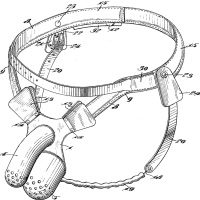After a discussion with her therapist, Ellen decides to tell the truth about her true repressed sexual orientation to her friends by inviting them over to her apartment to break the news so she can be at peace. Meanwhile, Ellen’s hopes for a relationship with Susan are dashed when she tells Ellen that she’s not interested, but gives Ellen further confidence to embrace her newfound life.
Monthly Archives: April 2012
The Puppy Episode
After a discussion with her therapist, Ellen decides to tell the truth about her true repressed sexual orientation to her friends by inviting them over to her apartment to break the news so she can be at peace. Meanwhile, Ellen’s hopes for a relationship with Susan are dashed when she tells Ellen that she’s not interested, but gives Ellen further confidence to embrace her newfound life.
When Jesus Met Homeless LGBT Youth
Jesus was entering a town when homeless lesbian, gay, bisexual and transgender (LGBT) youth called out, “Have pity on me, Lord, Son of David!” Jesus ignored the young people and his disciples encouraged him to send them away. For a moment in the story, Christ turns to his disciples and aligns himself with them saying that he only came for the house of Israel. As the young people are ignored, they become persistent in calling out to Christ and finally Christ stops ignoring their cries for help, turns to the young people, and says, “O young people, great is your faith!”
Now perhaps you’re wondering where these words are in the Gospels, but we need only look at the story of the encounter between Jesus and the Canaanite woman to see that Christ stands with those in need. The story of the Canaanite woman is of particular relevance to the current situation involving Cardinal Timothy Dolan and the invitation for him to meet with homeless LGBT youth to hear their stories and dialogue with them. It is in the light of this Gospel reading from Matthew (15:21-28) that I hold great hope that Cardinal Dolan will follow the example of Christ and that even amid calls from others to simply “look the other way,” he will turn and stop ignoring the cries of young people in need.
The welcoming and all-inclusive message of Christ is further seen in the story of Zacchaeus (Luke 19: 1-10). When Jesus calls out to Zaccahaeus and tells him that he would like to stay at his home, the crowd refers to Zaccahaeus as “a sinner”; however, Jesus does not succumb to their words of condemnation, but rather sees Zaccahaeus as a “descendent of Abraham.”
Both of these stories remind me that the Church is at its core a welcoming and affirming assembly dedicated to living the message of Christ in a way that reaches the most vulnerable among us. The experience of the Canaanite woman demonstrates that even religious law is not always right and just, but rather sometimes we are called to witness truth in the present moment. In the case of Zaccahaeus, we are taught that Christ sees each of us as being created in God’s image and likeness.
When I launched the petition calling upon Cardinal Dolan to meet with homeless LGBT youth, hear their stories and dialogue with them, I did so because I believe the time has come for the Church to no longer ignore the stories of LGBT people, but rather to encounter and discern them. The notion that we live in a country where 30 percent to 40 percent of homeless youth are LGBT, should be startling enough to awaken the hearts of Catholic leaders so as to work with the community to solve this epidemic. The Church must recognize its role in creating an environment that is safe and affirming for all youth without exception. This is the Gospel message of inclusion.
In light of this call upon Cardinal Dolan, the reality is that the vast majority of Roman Catholics support their LGBT sisters and brothers. I have visited a number of parishes throughout the United States, where I have seen firsthand communities of faith living the message of inclusion. This is what we are calling upon the American hierarchy to witness — witness the prophetic voice of those in the pews and those who courageously preach the Gospel’s message not of law, but of peace and love. The petition to Cardinal Dolan does not challenge Church teaching, but rather it asks the Cardinal — and others in the American hierarchy — to look into the faces of homeless LGBT youth and in doing so look into the face of Christ. This petition is not a political statement nor a profession of faith, but rather it is a contemplative action that represents a society-wide prayer: a prayer that one day we might come to see the dignity that is inherent in every human being.
I hope you will join me, and nearly 2,000 other people of faith, in asking Cardinal Dolan to follow the humble example of a man who nearly 2,000 years ago stopped ignoring a woman because of laws, turned to her, listened and witnessed the great faith she exhibited. This same man sought a place to rest in the home of person that others deemed a sinner, but Christ saw as a righteous man in the eyes of God. It is with this understanding of Christ, that I launched the petition inviting Cardinal Dolan to enter into a dialogue with those most in need, so as to begin to understand the LGBT experience and see the dignity of the human person. Perhaps at that moment, Dolan will turn to our community and say, “My gay, lesbian, bisexual, and transgender sisters and brothers, great is your faith” and “Today salvation has come to this house because LGBT people are descendants of Abraham.”
Gay Student Says Attack Was A Hate Crime
An openly gay Illinois State University student had to have his jaw wired shut after allegedly being beaten by a group of men who shouted homophobic slurs as he was returning home after a party.
“They just wanted to hurt somebody,” Unger, a family relations major who hopes to work with LGBT youth, recalled for CBS. “The last thing I remember is just being blindsided by six or eight guys, and then I woke up on the concrete.”
SOURCE: Huffington Post, Eric Unger, Gay Illinois State University Student, Claims Brutal Attack Was Hate Crime. 04/25/2012 by
Morning Express
An English war poet, Sassoon was also known for his fictionalised autobiographies, praised for their evocation of English country life.
Siegfried Sassoon was born on 8 September 1886 in Kent. His father was part of a Jewish merchant family, originally from Iran and India, and his mother part of the artistic Thorneycroft family. Sassoon studied at Cambridge University but left without a degree. He then lived the life of a country gentleman, hunting and playing cricket while also publishing small volumes of poetry.
In May 1915, Sassoon was commissioned into the Royal Welsh Fusiliers and went to France. He impressed many with his bravery in the front line and was given the nickname ‘Mad Jack’ for his near-suicidal exploits. He was decorated twice. His brother Hamo was killed in November 1915 at Gallipoli.
In the summer of 1916, Sassoon was sent to England to recover from fever. He went back to the front, but was wounded in April 1917 and returned home. Meetings with several prominent pacifists, including Bertrand Russell, had reinforced his growing disillusionment with the war and in June 1917 he wrote a letter that was published in the Times in which he said that the war was being deliberately and unnecessarily prolonged by the government. As a decorated war hero and published poet, this caused public outrage. It was only his friend and fellow poet, Robert Graves, who prevented him from being court-martialled by convincing the authorities that Sassoon had shell-shock. He was sent to Craiglockhart War Hospital in Edinburgh for treatment. Here he met, and greatly influenced, Wilfred Owen. Both men returned to the front where Owen was killed in 1918. Sassoon was posted to Palestine and then returned to France, where he was again wounded, spending the remainder of the war in England. Many of his war poems were published in The Old Huntsman (1917) and Counter-Attack (1918).
After the war Sassoon spent a brief period as literary editor of the Daily Herald before going to the United States, travelling the length and breadth of the country on a speaking tour. He then started writing the near-autobiographical novel Memoirs of a Fox-hunting Man (1928). It was an immediate success, and was followed by others including Memoirs of an Infantry Officer (1930) and Sherston’s Progress (1936). Sassoon had a number of homosexual affairs but in 1933 surprised many of his friends by marrying Hester Gatty. They had a son, George, but the marriage broke down after World War Two.
He continued to write both prose and poetry. In 1957, he was received into the Catholic church. He died on 1 September 1967.
The Conch Republic
The Conch Republic was established by secession of the Florida Keys from the United States of America, on April 23rd, 1982 in response to a United States Border Patrol Blockade setup on highway U.S.1 at Florida City just to the north of the Florida Keys. This heinous act effectively isolated Keys Citizens from the U.S. mainland since the blockade was on our only land artery to and from the mainland. This roadblock portrayed Keys residents as non-U.S. citizens who had to prove their citizenship in order to drive onto the Florida mainland! Hardly an American thing to do!
Today, the Conch Republic celebrates its thirtieth birthday. The thirtieth anniversary celebration runs from April 20-29. The gay community of Key West joins in o the celebration with several events at the Bourbon Street Pub. Key West’s Great Conch Republic Drag Race wore Saturday. The race featured 16 high-heeled female impersonators navigating across an obstacle course filled with automobile tires and scantily-clad passengers in shopping carts. According to the Florida Keys News Bureau, the race was hosted by the republic’s Bourbon Street Pub Complex, where contestants raced down Duval Street, or the fittingly nicknamed “main drag.” The wacky drag challenge has been held annually since 1982 as part of Key West’s independence celebration. This year’s celebration runs through April 29th, filled with other events to look forward to such as a reenactment of the secession, a fun sea battle with tall ships, and an open-air bed race that’s said to be “the most fun you can have in bed with your clothes on.”
 The City of Key West is a menagerie of people from all walks of life. The people of Key West are fortunate to live in a tolerant community that respects and celebrates differences. They have a vibrant gay and lesbian community and Key West has been ranked as one of the “Top Gay and Lesbian Destinations” in the world. This spirit of tolerance is evident everywhere on the Island. Filled with a funky charm, Key West is a sophisticated place with amazing restaurants, diverse entertainment, eclectic art, professional theatre, and live music that includes salsa, show tunes, disco, country, opera, and classical. Key West’s gay and lesbian guest houses are legendary, and our mainstream hotels and inns are always All Welcome. Drag shows, commitment ceremonies, water excursions, late night parties, beaches, clothing optional resorts, and the only gay & lesbian historic trolley tour make our island the preeminent LGBT vacation choice. But the best part about our town is our open and accepting attitude. “One Human Family” is our city motto, and our closets are only used for our costumes!
The City of Key West is a menagerie of people from all walks of life. The people of Key West are fortunate to live in a tolerant community that respects and celebrates differences. They have a vibrant gay and lesbian community and Key West has been ranked as one of the “Top Gay and Lesbian Destinations” in the world. This spirit of tolerance is evident everywhere on the Island. Filled with a funky charm, Key West is a sophisticated place with amazing restaurants, diverse entertainment, eclectic art, professional theatre, and live music that includes salsa, show tunes, disco, country, opera, and classical. Key West’s gay and lesbian guest houses are legendary, and our mainstream hotels and inns are always All Welcome. Drag shows, commitment ceremonies, water excursions, late night parties, beaches, clothing optional resorts, and the only gay & lesbian historic trolley tour make our island the preeminent LGBT vacation choice. But the best part about our town is our open and accepting attitude. “One Human Family” is our city motto, and our closets are only used for our costumes!
One of these days, I am going to have to visit Key West. It sounds like a fantastically fun place, and one of my favorite writers, Ernest Hemingway, used to live there. Hemingway lived and wrote in Key West for more than ten years beginning in the 1930s. Calling Key West home, he found solace and great physical challenge in the turquoise waters that surround this tiny island.





























